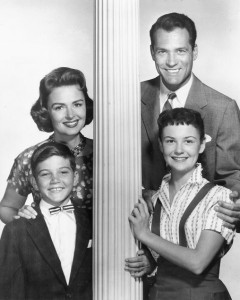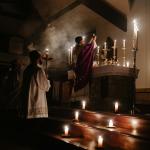The doors of St. Mary’s Church, on the corner of University and College, in Tempe, are locked. Black plastic covers the steeple. Chain-link fences surround it. Behind those fences sit backhoes and earth-movers. The place is under repair, but to the uninformed eye it might almost be under siege.
Dating back to 1903, St. Mary’s is the oldest Catholic church in the Valley of the Sun and a National Historical Landmark. Constructed from red brick with arched gothic-revival windows, it looks quaint from the outside. With its white walls and hardwood floors, its interior is all austerity – or would be, if those windows didn’t admit an exhilarating flood of light. The rose window just below the steeple features an Agnus Dei motif intricate enough to have been stolen from an Ivy League university chapel (though I have it on good authority it wasn’t).
If you’re in no mood for a shakedown, reader, then by all means quit reading now. Technically, St. Mary’s belongs to the All Saints Catholic Newman Center, which has been serving Arizona State University’s student body since 1968. Fittingly, parishioners call it the Old Church. In reality, St. Mary’s belongs to the Arizona sun. Since 1995, when the church underwent its last renovations, that sun has worked so much mischief on the structure that parish administrators have had to close it down.
Currently, they’re working — and spending — their way through an extensive wish list. Along with replacing the wooden shake covering the steeple with shingles of a stronger material, they mean to resurface the windows, currently covered by sun grills, and restore the bricks to match those of ASU’s Old Main building, just across University Drive. Perhaps more vitally, they want to replace the air-conditioning system, already older than the students who make up the mainstay of the parish.
The problem is funding. Students are not known for crouching atop hoards of disposable income. The Arizona state legislature, though generous with grants in the past, has been clutching its pocketbook this time around, at least so far. To reach its goals for St. Mary’s and put the old girl back into commission, the Newman Center must pass the hat – round and round and round.
But let’s return back to the quaintness for just a moment. It’s a quality in desperately short supply here in the Metro Phoenix Area. Yes, we have a few historic neighborhoods – Arcadia, Encanto Vista, Oakland and Woodland. But rather than harmonize with the modern city, they tend to be tucked away or blocked off somewhere behind it. In the Valley, thanks to the sun and – during monsoon seasons – the whirling sands, whatever isn’t renewed or replaced, starts looking dingy and falls into decay. Not for nothing was the region’s metropolitan hub named for a bird that resurrects itself repeatedly from its own ashes.
Tempe was once a exception to this rule. On ASU’s campus, the solar panels above Hayden Library and Frank Lloyd Wright’s futuristic Gammage Center co-existed with Old Main, built with bricks fired in the same kiln as the ones in St. Mary’s. Casey Moore’s Oyster House and Monti’s La Casa Vieja anchored the downtown bars, boutiques and tattoo parlors in some semblance of tradition.
Though Casey Moore’s is still operational (and still, reportedly, haunted), Monti’s sold out last November to developers who have plans to cover the spot with a 15-story office building. Now that ASU’s enrollment is breaking records at 82,000 students, the area surrounding its main campus has exploded in new constructions of glass and steel. At the tender age of 120, Tempe is already sprouting its first skyline.
A donation toward the restoration of St. Mary’s, then, is an investment in quaintness, which in turn is an investment in evangelism. This morning I spoke to Ric Blazquez, the Newman Center’s director for development, who told me he hoped to attract support from non-Catholics by calling attention to the church’s less explicitly religious merits – its age, for example, and its place in Valley history. Initially upon hearing this, I winced. Keeping a church alive and relevant by recasting it as a curiosity sounded so self-consciously post-Christian, so…European.
But then it occurred to me that my thinking was too narrow. If a turn-of-the-century red brick church hemmed in by functional glitz catches eyes by being old and curious, fine. Those qualities can work as a beacon – a light, if you will, for the gentiles. If the goyim can be inveigled onto guided tours, so much the better.
I have to admit, it worked that way on me. For the first 16 years I lived in the Valley, St. Mary’s burrowed into my consciousness simply by standing a bottle’s throw from the patio bar where my mortgage company held its team builders. More than St. Patrick’s Cathedral, even more than St. Peter’s Basilica, St. Mary’s Church had come to represent the Church. On that December morning when a mysterious impulse prompted me toward my first Mass ever, there was no question where I’d take it.
Old-fashioned, still strangely beautiful, but increasingly dependent on the kindness of strangers – that might not be a bad summary of the Church as a whole these days. With your generosity, which you can express at this website, you’ll do more than guarantee a pleasant worship experience for a bunch of far-off Arizonans. You’ll also help to maintain a pretty darned good metaphor.















